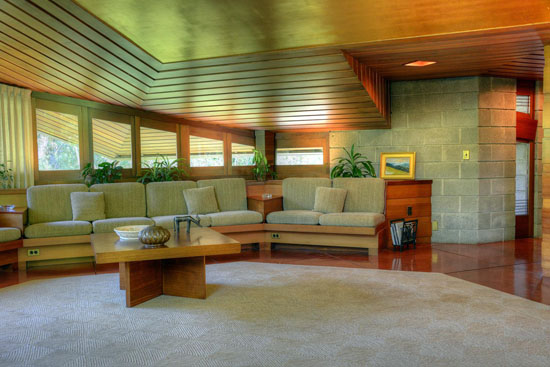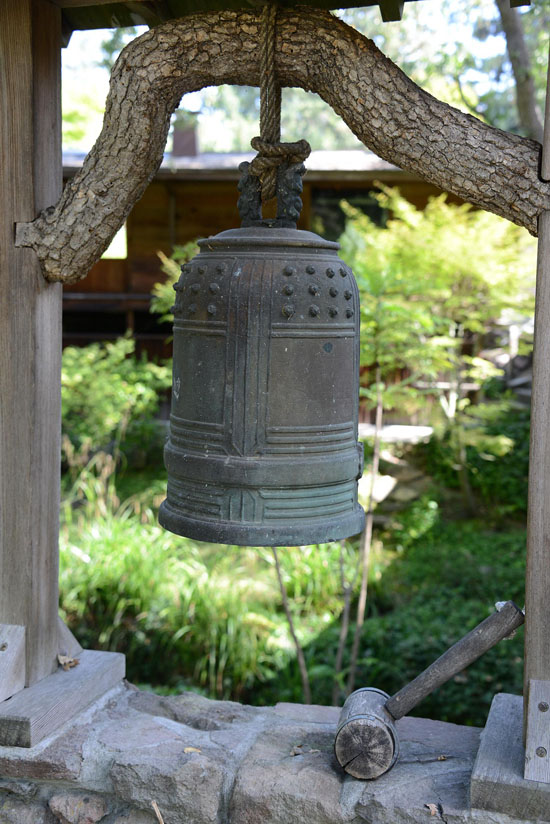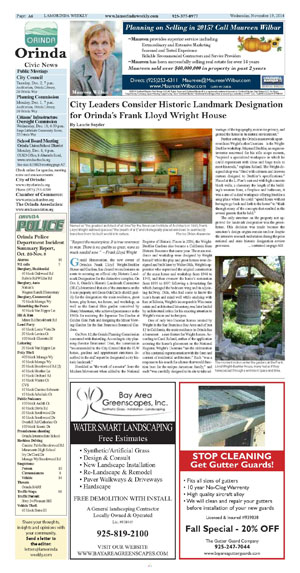|
|
Published November 19th, 2014
|
City Leaders Consider Historic Landmark Designation for Orinda's Frank Lloyd Wright House
|
|
| By Laurie Snyder |
 |
| Named as "the greatest architect of all time" by the American Institute of Architects in 1991, Frank Lloyd Wright defined space as "the breath of art," and strategically placed windows to seamlessly transition from his built world into nature. Photos Ohlen Alexander |
"Respect the masterpiece. It is true reverence to man. There is no quality so great, none so much needed now." - Frank Lloyd Wright

 Gerald Shmavonian, the new owner of Orinda's Frank Lloyd Wright-Buehler House and Gardens, has cleared two milestones en route to securing an official city Historic Landmark Designation for the distinctive complex. On Oct. 1, Orinda's Historic Landmark Committee (HLC) determined that six of the structures on the 3-acre property at 6 Great Oak Circle should qualify for the designation: the main residence, guest house, play house, tea house, and workshop, as well as the formal Shin garden conceived by Henry Matsutani, who achieved prominence in the 1960s for restoring the Japanese Tea Garden at Golden Gate Park and designing the Moon Viewing Garden for the San Francisco Botanical Gardens.
Gerald Shmavonian, the new owner of Orinda's Frank Lloyd Wright-Buehler House and Gardens, has cleared two milestones en route to securing an official city Historic Landmark Designation for the distinctive complex. On Oct. 1, Orinda's Historic Landmark Committee (HLC) determined that six of the structures on the 3-acre property at 6 Great Oak Circle should qualify for the designation: the main residence, guest house, play house, tea house, and workshop, as well as the formal Shin garden conceived by Henry Matsutani, who achieved prominence in the 1960s for restoring the Japanese Tea Garden at Golden Gate Park and designing the Moon Viewing Garden for the San Francisco Botanical Gardens.
 On Nov. 12, the Orinda Planning Commission concurred with that ruling. According to city planning director Emmanuel Ursu, the commission "recommended to the City Council that the FLW house, gardens and appurtenant structures described in the staff report be designated a city historic landmark."
On Nov. 12, the Orinda Planning Commission concurred with that ruling. According to city planning director Emmanuel Ursu, the commission "recommended to the City Council that the FLW house, gardens and appurtenant structures described in the staff report be designated a city historic landmark."
 Heralded as "the work of a master" from the Modern Movement when added to the National Register of Historic Places in 2006, the Wright-Buehler Gardens also became a California State Historic Resource that same year. The main residence and workshop were designed by Wright himself while the play and guest houses were designed and built later by Walter Olds, Wrig3ht's apprentice who supervised the original construction of the main house and workshop from 1948 to 1949, and then oversaw the home's restoration from 1995 to 1997 following a devastating fire which damaged the bedroom wing and its adjoining hallway. Olds, who had come to know the icon's heart and mind well while studying with him at Taliesin, Wright's incomparable Wisconsin estate and architectural laboratory, was later lauded by architectural critics for his exacting attention to Wright's vision and techniques.
Heralded as "the work of a master" from the Modern Movement when added to the National Register of Historic Places in 2006, the Wright-Buehler Gardens also became a California State Historic Resource that same year. The main residence and workshop were designed by Wright himself while the play and guest houses were designed and built later by Walter Olds, Wrig3ht's apprentice who supervised the original construction of the main house and workshop from 1948 to 1949, and then oversaw the home's restoration from 1995 to 1997 following a devastating fire which damaged the bedroom wing and its adjoining hallway. Olds, who had come to know the icon's heart and mind well while studying with him at Taliesin, Wright's incomparable Wisconsin estate and architectural laboratory, was later lauded by architectural critics for his exacting attention to Wright's vision and techniques.
 One of only two Usonian homes created by Wright in the San Francisco Bay Area and of just 12 in California, the main residence in Orinda has a basement - a rare feature for Wright homes. According to Carol Roland, author of the application securing the home's placement on the National Register, Wright's Usonians "are the culmination of his continual experimentation with the form and content of residential architecture." Each "was a response to his search for a house that would function best for the unique American family," and each "was carefully designed to its site to take advantage of the topography, maximize privacy, and ground the house in its natural environment."
One of only two Usonian homes created by Wright in the San Francisco Bay Area and of just 12 in California, the main residence in Orinda has a basement - a rare feature for Wright homes. According to Carol Roland, author of the application securing the home's placement on the National Register, Wright's Usonians "are the culmination of his continual experimentation with the form and content of residential architecture." Each "was a response to his search for a house that would function best for the unique American family," and each "was carefully designed to its site to take advantage of the topography, maximize privacy, and ground the house in its natural environment."
 Further setting the Orinda masterwork apart - even from Wright's other Usonians - is the Wright-Buehler workshop. Maynard Buehler, an engineer-inventor renowned for his rifle scope mounts, "required a specialized workspace in which he could experiment with ideas and forge tools to meet his needs," explains Roland. The Wright-designed shop was "fitted with cabinets and drawers custom designed to Buehler's specifications." Placed at the L-Plan's east end with high concrete block walls, a clerestory the length of the building's western front, a fireplace and bathroom, it was a one-of-a-kind workspace offering Buehler a snug place where he could "spend hours without having to go back and forth to the house" to "think through many of the concepts that resulted in the several patents that he held."
Further setting the Orinda masterwork apart - even from Wright's other Usonians - is the Wright-Buehler workshop. Maynard Buehler, an engineer-inventor renowned for his rifle scope mounts, "required a specialized workspace in which he could experiment with ideas and forge tools to meet his needs," explains Roland. The Wright-designed shop was "fitted with cabinets and drawers custom designed to Buehler's specifications." Placed at the L-Plan's east end with high concrete block walls, a clerestory the length of the building's western front, a fireplace and bathroom, it was a one-of-a-kind workspace offering Buehler a snug place where he could "spend hours without having to go back and forth to the house" to "think through many of the concepts that resulted in the several patents that he held."
 The only structure on the property not approved for landmark designation was the greenhouse. This decision was made because the structure's design origins remain unclear despite the intensive research undertaken during the prior national and state historic designation review processes.
The only structure on the property not approved for landmark designation was the greenhouse. This decision was made because the structure's design origins remain unclear despite the intensive research undertaken during the prior national and state historic designation review processes.
 In reaching their respective decisions, HLC members and planning commissioners determined that the Wright-Buehler complex met the following criteria: the home and gardens represent "a distinctive example of an architectural period, style or movement or its identification as the work of an architect or master builder," has "elements of architectural design, detail, materials or craftsmanship which represent a significant architectural innovation," and "is a distinct work of art."
In reaching their respective decisions, HLC members and planning commissioners determined that the Wright-Buehler complex met the following criteria: the home and gardens represent "a distinctive example of an architectural period, style or movement or its identification as the work of an architect or master builder," has "elements of architectural design, detail, materials or craftsmanship which represent a significant architectural innovation," and "is a distinct work of art."
 The Orinda City Council is expected to review the Wright-Buehler House landmark application sometime in the new year.
The Orinda City Council is expected to review the Wright-Buehler House landmark application sometime in the new year.
 For an exclusive look at this architectural masterpiece, view Ohlen Alexander's photographs in our Sept. 24 article, "Frank Lloyd Wright House in Orinda a Structural Symphony" at www.lamorindaweekly.com.
For an exclusive look at this architectural masterpiece, view Ohlen Alexander's photographs in our Sept. 24 article, "Frank Lloyd Wright House in Orinda a Structural Symphony" at www.lamorindaweekly.com.

|
 |
| The moment visitors enter the gardens at the Frank Lloyd Wright-Buehler House, many feel as if they have passed through a wrinkle in space and time. |
|
|
|
|
|
|
| |
|
|
|
|





